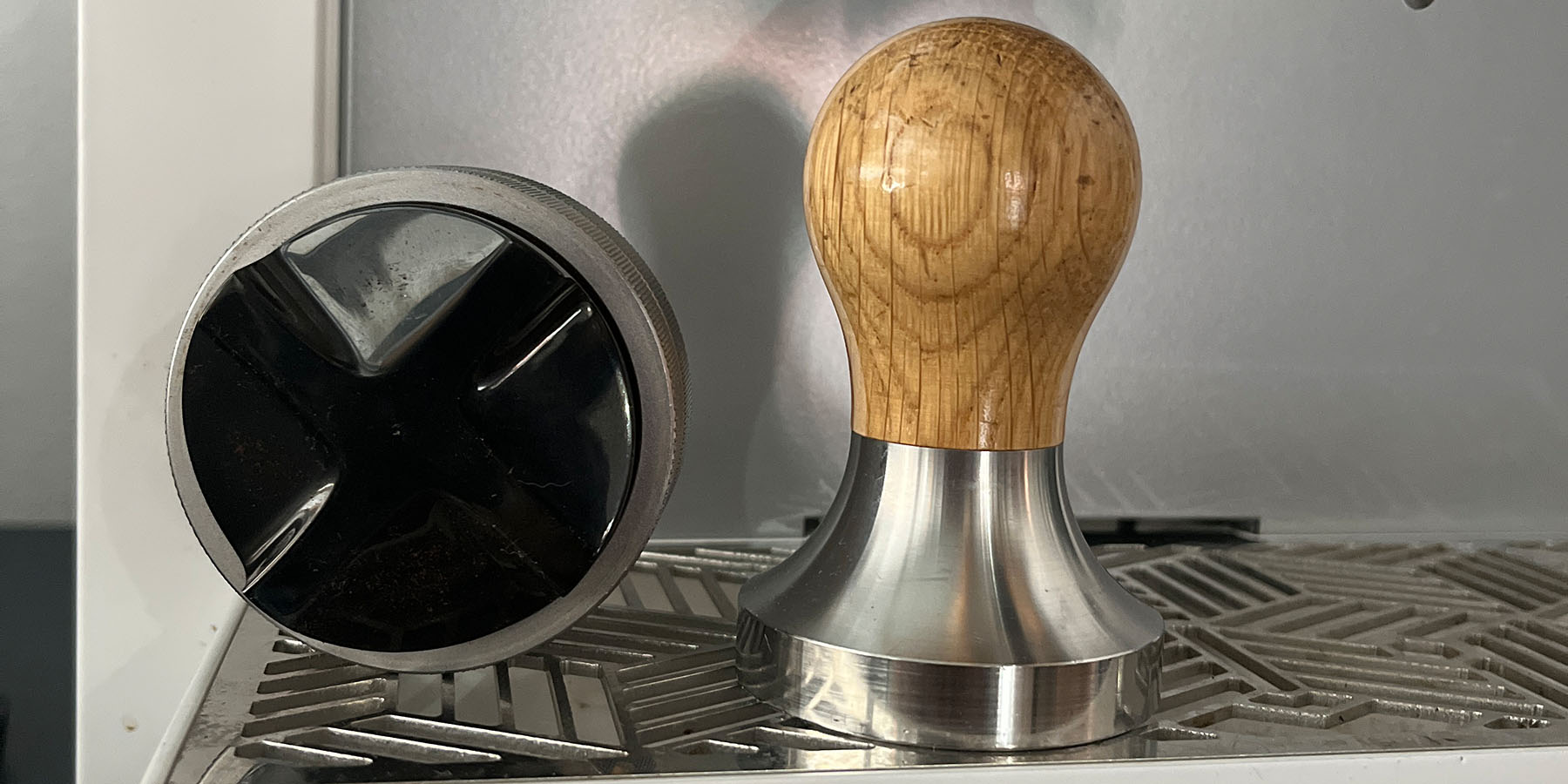If you want espresso, you have to tamp your coffee properly . The espresso will only taste good if the coffee puck is compressed correctly in the portafilter. But tamping is not the only thing responsible for this, because before tamping comes leveling - and perhaps that is even more important than tamping. One thing is certain: for good and tasty espresso, tamping and leveling are useful - in fact, a must. Here you can find out how!

Tampering and Leveling – Physics Lesson
Water and electricity always seek the path of least resistance. In our case - when making espresso in a portafilter - it is very important that we give the water no choice. Instead, we force it to take the path we tell it to. The goal is for the water from the machine to penetrate all of the ground coffee in the sieve and extract the aromas. To make this work, we have to tamper and level our coffee properly. Otherwise, cracks, channels and other imponderables will form through which the water will find its way and not wet enough of the ground coffee during extraction, meaning our espresso will be sour, bitter and disgusting.
Tamping coffee correctly – Leveling
What we want is optimally distributed coffee powder in the portafilter. So that the water touches every particle of coffee evenly and extracts the aromas. The challenge here is that there is no coffee grinder on the market that distributes the ground coffee evenly in the portafilter. Basically , a small mountain always forms in the middle of the portafilter. If we were to simply tamp without leveling, the puck would be much more compact and dense in the middle than at the edge. More water would flow through at the edge and less in the middle of the puck. That's why we have to level properly. And here we can even make more mistakes than with tamping.

How to level coffee properly?
There are different techniques for leveling. Some are good, some are less good. Of course, you can choose which method or even a combination of several, but we will also tell you which ones are more or less effective.
Leveling correctly - the finger method
When it comes to the finger method, there are those who have no plan and who rub the coffee powder in the sieve in all directions, those who rub from top to bottom, those who level the coffee powder from left to right and those who go over the coffee powder from all directions. All of these methods are good, but they are not very effective. This is because you rub the powder smooth at the top, but differences in density can still remain in the depths .
Leveling correctly – the patting method
With the patting method, you tap – or pat – the portafilter with your hand from the side. As if you wanted to say: "You are good the way you are and you will make a great espresso." This sentence also corresponds roughly to the length of time you need to pat. After that, the ground coffee in the portafilter is well distributed horizontally and more homogeneously compacted vertically . You can choose whether you only pat from one side or alternate between different sides.
Extra tip: Try a combination of the sieve-against-the-counter method and the patting method. This will probably produce the best results.
The sieve-against-counter method
You take the sieve and tap it firmly, but not too hard, on the counter. The pile in the portafilter shrinks and spreads out to the edges of the sieve, while at the same time the coffee powder in the sieve becomes more evenly compacted. But even if the pile shrinks, it doesn't disappear completely. There is still an imbalance in the density of the coffee powder , which means that the puck is less penetrated by water in some places when tamping.
Leveling up properly – with devices
Of course, industry has also recognized how important leveling is and has developed a ton of cool, practical and sometimes expensive devices for it. Basically, they do exactly the same thing that you can do with your hand. Some devices do it better, some don't. Especially at the beginning of your espresso career, you don't need any of these devices and certainly not one that is really expensive. For example: Levelers or distributors can cost up to 200 euros or more. Of course, you can buy one of these things if you want. In our shop you can find, for example, the Leveler NCD from Nucleus Tools and the Equalizer from Hauck .
How to tamper coffee properly?
Tamping correctly is not rocket science. Take the tamper, hold the handle in the palm of your hand, place your thumb and index finger on the top of the tamper and then press vertically onto the coffee grounds in the sieve. Then pull it out again. Done. You often read and hear that you need 15 kg of pressure to tamp coffee correctly. Yes and no, 10 kg will do the trick, and 12 will too. What we mean by this is that the exact pressure weight is not that important – and above all, it cannot be measured precisely. This is simply to say that when tamping correctly, you need to use just enough force to press the air out of the coffee grounds . The exact number of kilograms is not really that important. As soon as you feel counter pressure from the counter, it is clear that the resistance-free air has already escaped from the coffee grounds. And that means you have tamped enough. Everything else is just a battle of the barista against the counter.

Tamping coffee correctly – the hand tamper
We all know tampers; they look like oversized metal stamps. The most common is the normal hand tamper, which is operated using muscle power. It doesn't have to be exactly 15 kg of pressure, but with a little practice and the right tamper, you too will be able to tamper coffee properly.
There are also hand tampers that are pre-calibrated to 15 kilograms - some even have fancy LED displays. You can get one, but you don't need one to tamper properly. It's basically all just newfangled nonsense so that the manufacturers can make money: But you should have a tamper from the start ... without it you can't make a good espresso.
Tamping coffee correctly -
the tamper machine
Believe it or not, there are machines that do the tamping for you. The most well-known are the automatic tampers from Puqpress . But there are other manufacturers too. Here, of course, it is guaranteed that the coffee grounds in the sieve are pressed with the same pressure each time. However, since they contain electronics, most automatic tampers cost a lot. For private use, such a machine is not really worth it - unless you need 50 or more espressos a day. Jokes aside, these machines are not bad for use in the catering industry, because you always have the same pressure and the barista also saves muscle power that can be used elsewhere.

Tamping coffee correctly – No tamper? No problem!
It can happen that you haven't bought a tamper yet, the one you have is missing or even broken - what do I do then? You shouldn't put untamped coffee in your portafilter , but you could look for something that will replace the tamper, at least temporarily. Our tip for this is something hard that fits well into the sieve. Maybe a glass or a cup, maybe a thin bottle or a piece of wood with the right diameter. But that only helps for the moment... in the long term I would rely on a tool made specifically for this purpose.

Tamping coffee correctly – the devices
In comparison to leveling, when tamping properly, you need to buy a device that is specifically designed for it. There are plenty of tampers on the market and they come in all shapes and sizes. It's best to take an evening and browse the internet, then you'll find the right tamper for you in your price range. With us, you'll only find one: the tamper from Hauck .
Tamping coffee correctly - Why?
As mentioned, water always takes the easiest path. So if you don't tamp or don't tamp properly, an imbalance occurs in the coffee puck. The puck is tamped at an angle or has a higher density here and there and a lower density in other places. All of this means that the water takes these channels on its way through the puck and only extracts part of the coffee powder. And then the espresso becomes undrinkable.
Tamping coffee correctly – what if I don’t?
When the espresso is channeled - when the water only takes certain channels through the puck - it usually tastes watery because not all of the powder is extracted . At the same time, it can also become overly sour and bitter. And 18 grams of coffee are wasted. We don't want that and you don't want that either. So please tamp properly - and above all, level properly before tamping. Because leveling is perhaps even more important as a step before tamping.
Tamping coffee correctly – Conclusion
As you can see, tamping coffee properly is not rocket science . And yet it is extremely important for a tasty espresso. The industry offers a lot of bells and whistles and guidelines for this, and as a result, people often don't know what they're doing. You should be more dignified than fancy here. With enough practice, anyone can tamper properly. And if you also consider not to shake the portafilter and thus the puck too much after tamping - knocking, banging it against the portafilter holder with force, etc. - then the espresso will work too. So #staywild and enjoy your coffee.



